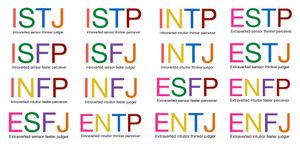The MBTI Personality Test

The Myers-Briggs Type Indicator, or MBTI, is a widely recognized personality test that aims to help individuals gain a deeper understanding of themselves and their personality traits.
Taking the MBTI test is fairly straightforward. For 15-20 minutes, you answer a series of questions that delve into your preferences and behaviors. These questions are designed to measure four key dimensions of your personality:
Extraversion (E) vs. Introversion (I)
This dimension assesses whether you are more outgoing and energized by social interactions (Extraversion) or if you tend to recharge through alone time and introspection (Introversion).
Sensing (S) vs. Intuition (N)
This looks at how you gather information. Sensing types rely on facts, details, and practicality, while Intuitive types focus on possibilities, patterns, and big-picture thinking.
Thinking (T) vs. Feeling (F)
This dimension examines how you make decisions. Thinking types prioritize logic and objectivity, while Feeling types consider values, emotions, and personal considerations.
Judging (J) vs. Perceiving (P)
This describes how you approach tasks and planning. Judging types prefer structure, organization, and closure, while Perceiving types are more flexible, spontaneous, and adaptable.
Once you have answered all the questions, you receive a four-letter code that represents your personality type. For example, if you get "ENTJ," it means you are an Extraverted, Intuitive, Thinking, and Judging individual. In that moment, you might feel that the test really captured who you are, or you might be surprised and want to think about your tendencies anew.
According to an article from Forbes, some companies use these assessments to gauge whether a candidate's personality aligns with a job role. This seems unwise. People are complex, and a simple four-letter code cannot fully express their potential.
The MBTI has value as a tool for self-reflection and even fun. It can provide insights into your natural inclinations and help you understand your strengths and weaknesses. However, it should not be used to evaluate others in a serious way. People are multidimensional, and their skills and abilities cannot be captured by a personality test.
Sources: 16personalities.com, forbes.com
For source links, see the article on ESLNewsStories.com
Useful Language
- Trait (n) - quality, characteristic
- Straightforward (adj) - not complicated
- Delve into (phr. v) - to research, to explore
- Recharge (v) - to get energy again after it was reduced
- Introspection (n) - looking inside oneself, thinking about one’s thoughts and feelings
- Prioritize (v) - to consider certain things more important and deal with them first
- Closure (n) - feeling that something is finished
- Spontaneous (adj) - not planned, doing something suddenly when you want to do it
- Anew (adv) - again, in a new way
- Gauge (v) - to estimate, to evaluate
- Potential (n) - a person’s capacity for development
- Inclination (n) - wanting to do something, preference, tendency
Discussion
Discuss the following questions with your partner(s).
- What did this review make you think about? Did anything in the review surprise you?
- How well do you know yourself? Are you ever confused by what you do?
- Have you done a personality test like the MBTI? If so, what was the result?
- What makes people want to take personality tests? Are they for fun?
- Are you more introverted or extraverted? Give an example to support your answer.
- Do you focus on detail or more on ‘the big picture’?
- Are you more logical or emotional? Give an example if you can.
- Are you a spontaneous person? If not, how do spontaneous people make you feel?
- Do you plan your life? If so, how?
- How well can we know another person? In your answer, include a percentage.
- Is it reasonable for a company to use a personality test to help them hire someone? Why or why not?